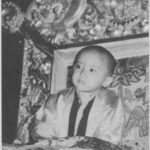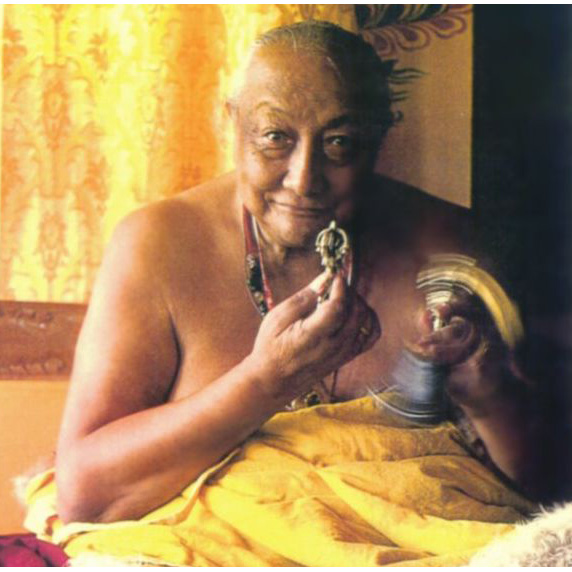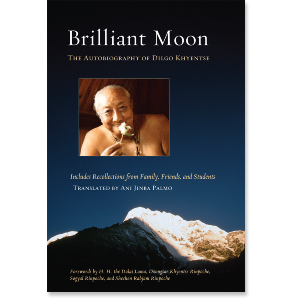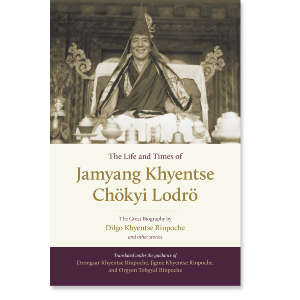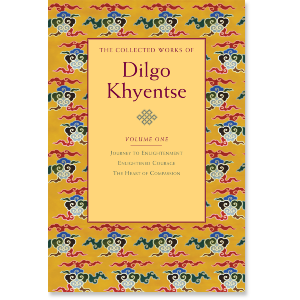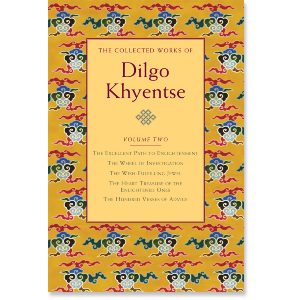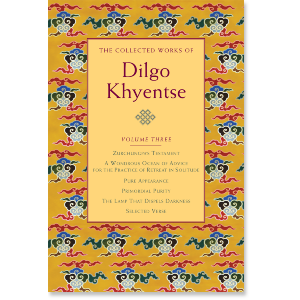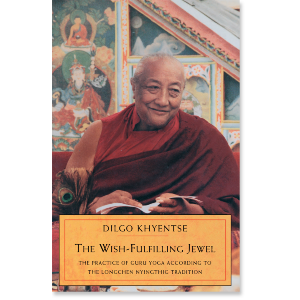| The following article is from the Winter, 1998 issue of the Snow Lion Newsletter and is for historical reference only. You can see this in context of the original newsletter here. |
A Detailed Account of the Enthronement of
Khyentse Yangsi Rinpoche
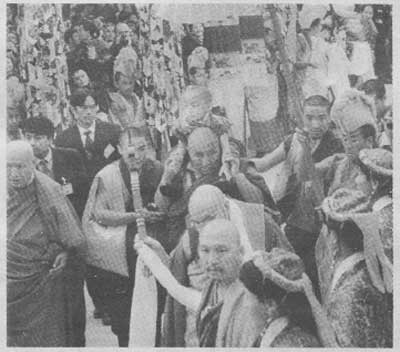
Yangsi Rinpoche's arrival in Procession (Photo: Vivian Kurtz)
On December 5, 1997, the Enthronement of Ugyen Tendzin Jigme Lhundrup, Khyentse Yangsi Rinpoche (born in Nepal on the 30th of June 1993) - the Reincarnation or "Yangsi" of Dilgo Khyentse Rinpoche, was celebrated at Shechen Monastery in Baudha, Nepal. Dilgo Khyentse Rinpoche (1910-1991) was one of the most remarkable Buddhist teachers of this century, an accomplished master in the Rimé or non-sectarian tradition, who had a deep knowledge of the teachings of all schools of Tibetan Buddhism.
For two days proceeding the actual enthronement ceremony, Trulshik Rinpoche, Dilgo Khyentse Rinpoche's close friend and disciple, performed a long-life ceremony in the upper temple which contains a startlingly lifelike statue of Khyentse Rinpoche and a small golden stupa containing his relics. For the actual event, the courtyard of the monastery with its newly painted buildings was covered by a large yellow tent and dotted with bright bunches of flowers.
As the morning mist lifted, the guests began to arrive. A total of about 15,000 people from over forty countries attended the enthronement. Almost all of them had either taken teachings from the previous Dilgo Khyentse Rinpoche or felt a strong connection to him.
The little Yangsi, who was four and a half years old, was greeted by Rabjam Rinpoche on his arrival, and carried aloft to the temple along a pathway carpeted with auspicious symbols made from colored rice, escorted by a procession of sacred dancers and two prancing snow lions. As he crossed the courtyard to the sound of horns, a hushed atmosphere of joy and emotion filled the gathered crowd. As many as possible were seated in the temple. Closed circuit television was provided for those in the courtyard to bring the event live to all those attending.
In the large, magnificently painted temple, the Yangsi sat on a chair while Trulshik Rinpoche conducted a purification ceremony to dispel any obstacles to his life and accomplishment of the Dharma. After that, he was seated on the throne of his predecessor and offered the symbols of the body, speech, mind, qualities and activity of a Buddha, and a long-life ceremony.
An explanatory speech written by Thilshik Rinpoche described the series of emanations of Khyentse Rinpoche beginning with Manjushri until the present Yangsi. Then there was the offering of the mandala, representing the entire universe, and Trulshik Rinpoche offered the young tulku the eight auspicious symbols and eight auspicious substances.
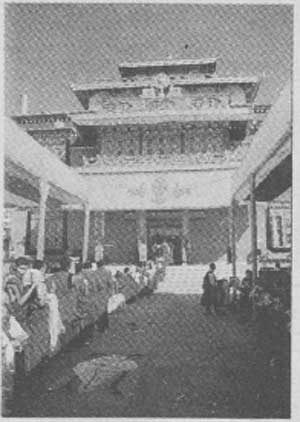
Procession far enthronement, to monasterythe eight auspicious symbols in colored rice. (Photo: Vivian Kurtz)
Following this main ceremony, lamas and disciples made offerings of a white scarves, symbolic of pure motivation, and presented gifts, including the traditional offering of a statue, book, stupa, vase and phurba (representing enlightened body, speech, mind, qualities, and activity). Several monasteries offered 108 gifts including statues, ritual implements, books, carpets, rolls of brocade, and sacks of grain, held aloft by a line of monks.
Seated on the throne, wrapped in a brocade cape like the one worn by the previous Khyentse Rinpoche, the Yangsi put on the lotus hat. Throughout the whole ceremony he behaved with great dignity and a natural confidence and nobility. Often smiling and joking to the huge crowd of people before him, he accepted the offerings with rapt attention and care. He had a wonderful combination of the joy and freedom of a young child and the innate knowledge of what he should be doing. It was a glorious and joyful occasion.
The ceremony was a deeply moving religious event, not just a pageant. And it was a clear indication that the tradition of Tibetan Buddhism is strong and vital.
Shechen Rabjam Rinpoche, abbot of the Monastery, said of the ceremony,
"The Yangsi was seated on the throne from which he will radiate activities to preserve and propagate the dharma. Just like the enthronement of a king establishes his rule over the country, the enthronement of a tulku (reincarnation) sets the auspicious connection so that he can benefit sentient beings."
After the ceremony, the public had a chance to offer white scarves to the Yangsi. The long line of people (Nepali, Western, Tibetan, Bhutanese, Chinese) gathered to pay respects stretched across the courtyard and down toward the gates. The Yangsi patiently sat on his throne for seven hours, playing and blessing the line of well-wishers.
In the afternoon, a rarely performed Bhutanese sacred dance was offered by the Shechen Dancers followed by a lively and hilarious Snow Lion dance to the delight of the large crowd. For the next three days, in the mornings, offerings were presented to the Yangsi and in the afternoon dancers from Tibetan communities in exile throughout India and Nepal performed cultural and religious dances. Some of the dance troupes came from Dharamsala, the Tibetan Children's Village in Bir, the Riwoche Gesar Group, and Kalimpong. Lunch was served for over 1,000 people for the 5 days of events.
The ceremony was performed by Ven. Thilshik Rinpoche in the presence of Penor Rinpoche, Mindroling Trichen Rinpoche, Chogye Trichen Rinpoche, Drigung Kyabgon Rinpoche and many other important incarnate lamas, teachers, and disciples. The reincarnations of Dilgo Khyentse Rinpoche's two main teachers, Shechen Gyaltsab Rinpoche (who came from Shechen Monastery in Kham, Tibet) and Dzongsar Khyentse Rinpoche and were also present.
A total of about 15,000 people attended the enthronement representing forty countries, almost all of whom had taken teachings from the previous Dilgo Khyentse Rinpoche. The guests included one hundred and thirty-seven tulkus, representatives from all the schools of Tibetan Buddhism, and representatives of His Holiness the Dalai Lama and the Bhutanese Royal Family. There were over 1,200 guests from America and Europe, including the American and French Ambassadors, Gene Smith, Steven Seagal, Michael Aris, and Richard Gere.
The 190 monks of Shechen Monastery had worked for months on the preparations for the event. As such a large crowd was expected, careful organization and planning was needed so that the events could go smoothly. On the day of the event, each monk had a precise role to play in the organization and performance of the ceremony. As explained by Shechen Rabjam Rinpoche:
"There were many complicated aspects to the preparation of such a large event. We tried to make every effort so that all the many people attending the enthronement would feel included and be able to share in all the events. I am very pleased that everything went so well. We all have the profound wish that the qualities in this child will grow to equal those of our revered Guru in his previous life."
On December 12, the wangs (empowerments) and lungs (reading transmission) of the Collected Works (Khabum) of Dilgo Khyentse Rinpoche began. The was the first time that the transmission of the whole Khabum was given. The the empowerments were given by Trulshik Rinpoche and the reading transmission by Dzongsar Khyentse Rinpoche and Rabjam Rinpoche. The series took 3 weeks to complete and was attended by the Yangsi, the young Bhutanese tulku of Dudjom Rinpoche, and over a thousand people.
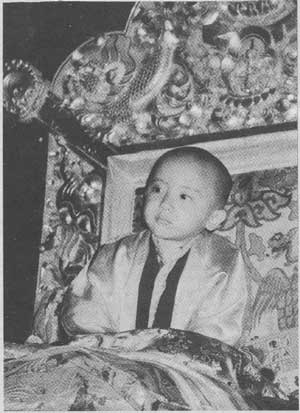
Yangsi Rinpoche on day of Enthronement. (Photo: Raphael Dernendre)
Now the Yangsi will begin his studies. Just as Shechen Rabjam was taught by Khyentse Rinpoche, it will be his turn to supervise the education of this young child, his teacher's reincarnation.
When Khyentse Rinpoche passed away in 1991, Ven. Trulshik Rinpoche, was entrusted to find the reincarnation. He did so through numerous visions that gave him a clear indication of who the reincarnation was. They revealed that the name of the father was Tsikey Chogling Rinpoche Mingyur Dewai Dorje, the third embodiment of Chogyur Dechen Lingpa, and that the mother was Dechen Paldron, and that their son born on June 30, 1993, was the unmistakable reincarnation of Dilgo Khyentse Rinpoche. His Holiness the Dalai Lama also confirmed that this child was Khyentse Rinpoche's reincarnation.
According to tradition, after the reincarnation was recognized, several steps were taken:
- First, the Yangsi was offered a name, ceremonial dress and a long-life blessing by Trulshik Rinpoche in the sacred cave of Maritika in Nepal to symbolize his future dharma activities.
- Then the young Tulku went to Dharamsala to meet His Holiness the Dalai Lama who performed the hair-cutting ceremony.

